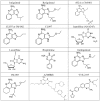Therapeutic applications of nucleic acids and their analogues in Toll-like receptor signaling
- PMID: 23151919
- PMCID: PMC6269001
- DOI: 10.3390/molecules171113503
Therapeutic applications of nucleic acids and their analogues in Toll-like receptor signaling
Abstract
Toll-like receptors (TLRs) belong to a family of innate immune receptors that detect and clear invading microbial pathogens. Specifically intracellular TLRs such as TLR3, TLR7, TLR8 and TLR9 recognize nucleic acids such as double-stranded RNA, single-stranded RNA and CpG DNA respectively derived from microbial components. Upon infection, nucleic acid sensing TLRs signal within endosomal compartment triggering the induction of essential proinflammatory cytokines and type I interferons to initiate innate immune responses thereby leading to a critical role in the development of adaptive immune responses. Thus, stimulation of TLRs by nucleic acids is a promising area of research for the development of novel therapeutic strategies against pathogenic infection, allergies, malignant neoplasms and autoimmunity. This review summarizes the therapeutic applications of nucleic acids or nucleic acid analogues through the modulation of TLR signaling pathways.
Figures


Similar articles
-
Therapeutic applications of nucleic acids as ligands for Toll-like receptors.Curr Opin Mol Ther. 2009 Apr;11(2):133-45. Curr Opin Mol Ther. 2009. PMID: 19330719 Review.
-
Recognition of nucleic acids by Toll-like receptors and development of immunomodulatory drugs.Curr Med Chem. 2010;17(18):1899-914. doi: 10.2174/092986710791163957. Curr Med Chem. 2010. PMID: 20377514
-
Toll-like receptors 7, 8, and 9: linking innate immunity to autoimmunity.Immunol Rev. 2007 Dec;220:251-69. doi: 10.1111/j.1600-065X.2007.00572.x. Immunol Rev. 2007. PMID: 17979852 Review.
-
Endosomal Toll-Like Receptors as Therapeutic Targets for Autoimmune Diseases.Adv Exp Med Biol. 2024;1444:97-108. doi: 10.1007/978-981-99-9781-7_7. Adv Exp Med Biol. 2024. PMID: 38467975
-
[Modulation of the host toll-like receptor signaling pathways by virus infection].Bing Du Xue Bao. 2012 Jun;28(4):453-61. Bing Du Xue Bao. 2012. PMID: 22978173 Review. Chinese.
Cited by
-
The Role of Nucleases Cleaving TLR3, TLR7/8 and TLR9 Ligands, Dicer RNase and miRNA/piRNA Proteins in Functional Adaptation to the Immune Escape and Xenophagy of Prostate Cancer Tissue.Int J Mol Sci. 2022 Dec 28;24(1):509. doi: 10.3390/ijms24010509. Int J Mol Sci. 2022. PMID: 36613950 Free PMC article.
-
De novo characterization of the spleen transcriptome of the large yellow croaker (Pseudosciaena crocea) and analysis of the immune relevant genes and pathways involved in the antiviral response.PLoS One. 2014 May 12;9(5):e97471. doi: 10.1371/journal.pone.0097471. eCollection 2014. PLoS One. 2014. PMID: 24820969 Free PMC article.
-
U1-RNP and Toll-like receptors in the pathogenesis of mixed connective tissue diseasePart II. Endosomal TLRs and their biological significance in the pathogenesis of mixed connective tissue disease.Reumatologia. 2015;53(3):143-51. doi: 10.5114/reum.2015.53136. Epub 2015 Aug 7. Reumatologia. 2015. PMID: 27407241 Free PMC article. Review.
-
Towards a better understanding of Lactobacillus rhamnosus GG--host interactions.Microb Cell Fact. 2014 Aug 29;13 Suppl 1(Suppl 1):S7. doi: 10.1186/1475-2859-13-S1-S7. Epub 2014 Aug 29. Microb Cell Fact. 2014. PMID: 25186587 Free PMC article. Review.
-
Survival of HT29 cancer cells is influenced by hepatocyte growth factor receptor inhibition through modulation of self-DNA-triggered TLR9-dependent autophagy response.PLoS One. 2022 May 12;17(5):e0268217. doi: 10.1371/journal.pone.0268217. eCollection 2022. PLoS One. 2022. PMID: 35551547 Free PMC article.
References
Publication types
MeSH terms
Substances
LinkOut - more resources
Full Text Sources
Other Literature Sources
Miscellaneous

